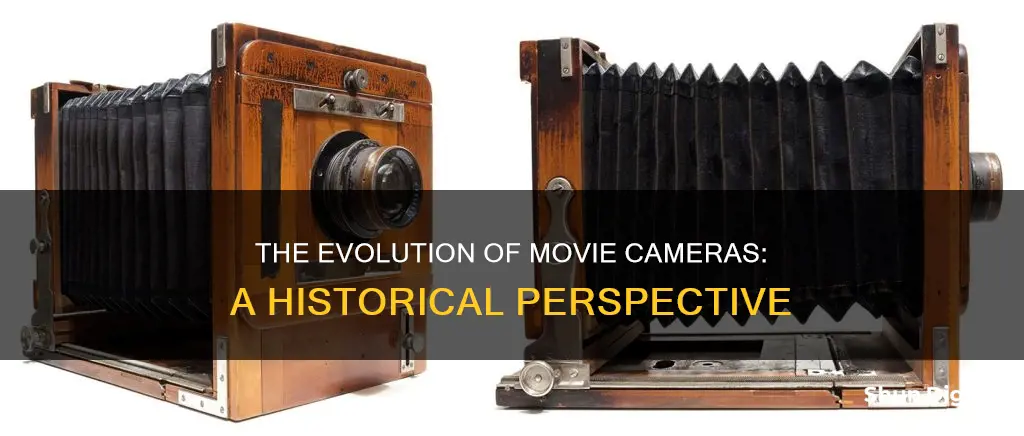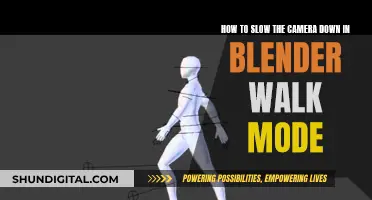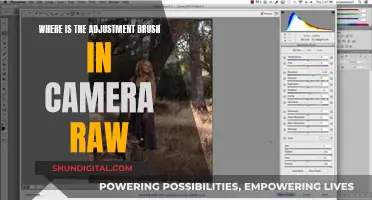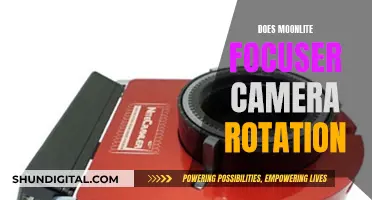
The history of the movie camera is a fascinating one, with several inventors developing early versions of the device in the late 19th century. The first movie camera is generally considered to be the Kinetograph, patented in 1891 by William Kennedy Laurie Dickson, a Scottish inventor employed by Thomas Edison. However, there were several other pioneers in the field, including Louis Le Prince, who in 1888 used a single-lens camera to shoot the oldest surviving film, Roundhay Garden Scene.
| Characteristics | Values |
|---|---|
| Date | 1890 |
| Inventors | Thomas Edison and William Dickson |
| Other names | Kinetograph, motion picture camera |
| Image capture | 40 frames per second |
| Image display | Kinetoscope |
| Image format | Long roll of celluloid photographic film |
| Image projection | 1894 |
| Image projection device | Kinetograph Parlors |
What You'll Learn

The first movie camera
The invention of the first movie camera is a story of mystery, intrigue, and multiple claimants. The creation of the first movie camera was a huge leap forward for the world, and many inventors were keen to be the first to develop such a device.
In 1888, the French artist and inventor Louis Le Prince built a single-lens camera and used it to film people walking in a garden. This film, known as the "Roundhay Garden Scene", is the oldest movie in existence. However, Le Prince's claim to have invented the first movie camera is disputed. This is because, in 1890, just before he was due to patent his invention and take it on a tour of America, he vanished. His wife suspected foul play, and in 2008, a magazine claimed that evidence had emerged showing that Thomas Edison, who was also working on a movie camera, had arranged Le Prince's assassination. However, the 'evidence' has never been proven, and Le Prince's disappearance remains a mystery.
Thomas Edison, the renowned American inventor, and his team had been working on a camera that could record moving images onto a cylinder since 1888. Within a few years, they had produced a camera that captured images onto a reel of 35mm film, which remains the standard format. In 1891, Edison's employee, the Scottish inventor William Kennedy Laurie Dickson, invented the first movie camera, called the Kinetograph. The Kinetograph was powered by an electric motor and was the first camera to take motion pictures on a moving strip of film. Edison's Kinetoscope and Kinetograph used 35mm celluloid film, invented by George Eastman. However, these films were viewed one at a time through a peephole, rather than being projected onto a screen.
Other early pioneers included the British inventor William Friese-Greene, who patented a moving picture camera in 1889, and the French scientist Étienne-Jules Marey, who invented the chronophotographic gun in 1882. This could shoot 12 images per second but did not use celluloid film. Wordsworth Donisthorpe also patented a camera, the Kinesigraph, in 1889, which could capture and project a series of images.
Black Backgrounds: Camera Raw Techniques
You may want to see also

The Kinetograph
> "I am experimenting upon an instrument which does for the Eye what the phonograph does for the Ear, which is the recording and reproduction of things in motion."
Once the film had been processed, it was shown using another device invented by Dickson, the Kinetoscope. This consisted of a film display mechanism inside a wooden cabinet with a peephole cut into the top. The Kinetoscope ran the film between an incandescent lamp and a magnifying lens, through which a single viewer, peering into the peephole, could watch the successive images. A slotted disk rotating between the film and the lens gave the viewer a momentary glimpse of each passing frame, creating a lifelike illusion of people and objects in motion.
The first public demonstration of the Kinetoscope was held at the Brooklyn Institute of Arts and Sciences on 9 May 1893. In 1894, Edison initiated public film screenings in recently opened "Kinetograph Parlours".
Finding the Synchronize Button in Camera Raw: A Quick Guide
You may want to see also

The Zoetrope
The name "zoetrope" comes from the Greek root words "zoe", meaning "life", and "tropos", meaning "turning", and translates to "wheel of life". The term was coined by inventor William E. Lincoln.
The first device of this type was invented in 1834 by British mathematician William Horner, who named it the Daedaleum, in reference to the Greek myth of Daedalus. However, the definitive zoetrope was invented in 1865 by William Ensign Lincoln, when he was just 18 years old and a sophomore at Brown University, Providence, Rhode Island. Lincoln's patented version had the viewing slits on a level above the pictures, allowing for the use of easily replaceable strips of images.
Over the years, zoetropes have been used for artwork, entertainment, marketing, and educational programs. They have also seen a revival in recent years, with companies such as Pixar creating 3D zoetropes featuring characters from popular animated films.
Applying Camera Raw Presets: A Step-by-Step Guide
You may want to see also

The Zoopraxiscope
Muybridge's zoopraxiscope projected images from rotating glass discs in rapid succession to give the impression of motion. The stop-motion images were initially painted onto the glass as silhouettes, with backgrounds eliminated to enable the creation of imaginary elements. Muybridge used the projector in his public lectures from 1880 to 1895. The machine was hand-cranked and related to other projecting phenakistiscopes, using slotted metal shutter discs that were interchangeable for different picture discs and effects.
A later series of 12-inch discs, made between 1892 and 1894, used outline drawings printed onto the discs photographically and then coloured by hand. These coloured discs were probably never used in Muybridge's lectures. All images of the known 71 discs, including the photographic disc, were rendered in an elongated form to compensate for the distortion of the projection.
How Shooting Raw Impacts Your Camera's Performance
You may want to see also

The Cinematographe
The Cinématographe was a motion-picture camera invented by Louis and Auguste Lumière in 1895. The Lumière brothers were manufacturers of photographic equipment based in Lyon, France. They were inspired to create a motion-picture camera after witnessing a demonstration of Thomas Edison's Kinetoscope in Paris in 1894.
The Cinématographe was a significant advancement in the history of cinema as it served multiple functions. It was not only a camera but also a photo developer and projector. This versatility allowed the Lumière brothers to exhibit their films to a wide audience, marking a pivotal moment in the evolution of cinema as a popular form of entertainment.
The Cinématographe was superior to Edison's Kinetograph in several ways. Firstly, it was lightweight (weighing less than 20 pounds) and portable, allowing for ease of transportation and placement. Secondly, it was manually operated by a hand-crank, as opposed to Edison's electrically powered camera, which was not readily portable. Moreover, the Cinématographe could project images onto a screen, enabling a large audience to view the films simultaneously. In contrast, Edison's Kinetograph lacked a projector, and only one person at a time could view the films through an eyepiece.
The Cinématographe produced sharper and clearer projected images than its predecessor. This was achieved through a unique design in which a fork-like mechanism held the frames behind the lens in place, utilising the perforations on the sides of the film strip. The Lumière brothers further refined their invention in 1897 by incorporating a glass flask of water as a condenser to enhance the illumination of the film frame and to dissipate heat.
The first public demonstration of the Cinématographe took place on December 28, 1895, at the Grand Café in Paris. This event marked a significant milestone in the history of cinema, as the Lumière brothers showcased ten short films, including "Workers Leaving the Lumière Factory" ("Sortie de l'usine Lumière de Lyon"). The Cinématographe became a popular attraction worldwide, captivating audiences from all walks of life and social standings.
Cropping Images: Adobe Camera Raw's Percentage Trick
You may want to see also
Frequently asked questions
The first movie camera was invented in the late 19th century. The Kinetograph, invented by Thomas Edison and his assistant William Dickson in 1890, is widely recognised as one of the world's first motion picture cameras.
Several leading inventors have been credited with creating the first motion picture camera. The Kinetograph, for example, was invented by Thomas Edison and his assistant William Dickson. However, it is now increasingly being accepted that the first movie camera was invented by Louis Le Prince, a Frenchman who emigrated to England.
The first movie ever made is thought to be "Roundhay Garden Scene", a film created by Louis Le Prince in 1888.







